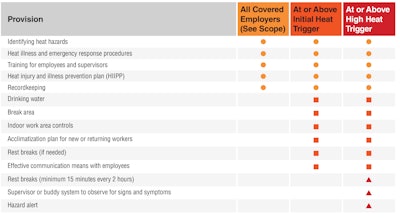Proposed OSHA Heat Rule Too Rigid, Construction Groups Say
Contractors would be required to provide paid breaks, shade, drinking water, training and other protections for workers.

Construction contractors would be required to provide paid breaks, shade, drinking water, training and other protections for workers in high heat, according to a proposed federal rule.
The proposal by the U.S. Occupational Safety & Health Administration would also require a written plan for protecting workers in the heat and an emergency-response plan in case of heat illness.
“Workers all over the country are passing out, suffering heat stroke and dying from heat exposure from just doing their jobs, and something must be done to protect them,” said OSHA Assistant Secretary Douglas L. Parker.
OSHA says about 40 workers on average die each year from heat exposure, and an average of 3,389 suffer heat-related injuries and illnesses daily that result in missed work.
Construction industry associations say many of the measures in the proposal are already being followed by contractors, but they oppose what they see as a lack of flexibility.
The Associated General Contractors calls the proposal a starting point, but says it needs to consider regional heat effects.
“In short, the impacts on worker safety of a 90-degree day in Mississippi are different than a 90-degree day in Alaska,” says AGC CEO Jeffrey D. Shoaf. “The final version of the rule should take into account regional differences in weather patterns.”
Shoaf adds that the rule does not take into account workers’ responsibilities for their own health.
“Heat safety does not begin at the jobsite, and the rule should include measures designed to reinforce the role workers play in protecting themselves,” he says. “These measures include self-hydrating, understanding how common health conditions and medications contribute to heat stress, and avoiding the excessive consumption of drinks containing caffeine and alcohol during periods of extreme heat.”
Greg Sizemore, vice president of health, safety, environment and workforce development of the Associated Builders and Contractors, fears the proposal as currently written could hinder heat-protection efforts contractors already take. He says that “protections must be flexible in response to the fluid nature of the construction environment.”
The proposed rule earned praise from worker advocacy groups as putting into law what has been enforced primarily by OSHA’s General Duty Clause, which requires workplaces to be free from recognized hazards that could cause death or injury.
"These protections ensure that employers proactively safeguard their workforce,” says Marcy Goldstein-Gelb, co-executive director of the National Council for Occupational Safety and Health. “Heat-related illnesses are preventable, and no worker should endure unsafe conditions. This rule provides a clear framework for promoting a culture of safety and responsibility."
What the Proposal Says
The proposal has two stages, when temperatures reach 80 degrees and high heat of 90 degrees.
Starting at a heat index of 80 degrees, it calls for each worker to have access to cool water every hour. Shaded or air-conditioned break areas must be provided.
When temperatures hit a heat index of 90 degrees, employers are required to provide paid rest breaks of at least 15 minutes every two hours in the cool break areas and notify employees of the heat hazard. They are also required to watch for signs of heat-related illness.
Other provisions of the proposal require employers to:
- Develop a site-specific heat injury- and illness-prevention plan if they have 10 or more employees.
- Monitor heat indexes and weather conditions to determine when workers need protection.
- Develop an “acclimatization plan” for new employees and those returning after more than 14 days off work by gradually exposing them to heat.
- Provide training on heat-related illness prevention.
- Develop a heat emergency-response plan.
 The above graphic shows the requirements for the proposed OSHA heat rule. "All Covered Employees" includes construction workers. "Initial Heat Trigger" is a heat index of 80 degrees. "High Heat Trigger" is a heat index of 90 degrees.CPWR
The above graphic shows the requirements for the proposed OSHA heat rule. "All Covered Employees" includes construction workers. "Initial Heat Trigger" is a heat index of 80 degrees. "High Heat Trigger" is a heat index of 90 degrees.CPWR
Construction groups say they are weeding through the 1,000-page proposal and will present their concerns.
“We look forward to working with federal officials to craft a final rule that includes effective measures for firms and workers to follow,” AGC’s Shoaf says. “That final rule should also avoid the kind of one-size-all approaches that will do more to hamstring firms than to protect workers.”

 machineryasia
machineryasia 



